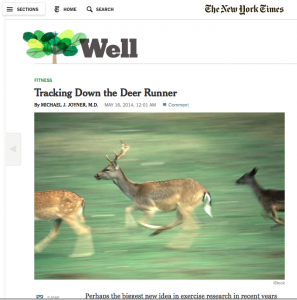Tracking Down the Deer Runner
click for article
This entry was posted on Friday, May 16th, 2014 at 7:28 am and is filed under Current Events, Elite Sports Performance. You can follow any responses to this entry through the RSS 2.0 feed. You can leave a response, or trackback from your own site.



May 19th, 2014 at 1:50 pm
The issue of evolution and adaptation to survive is a constant source of “what if” type questions. I have to really stretch some on the hunting issue and being able to run down antelope on a regular basis to feel that that ability is the result of evolutionary adaptation. To attempt to prove this theory one would also have to look at the history of a given tribe that hunts this way with the realization that they may not have been living in the same place now as they were 10 or 20,000 years ago or more, and would 10 or 20,000 years be sufficient for them to evolve on the evolutionary grid? Africa presents us with a history of migration of people. One of the points made in this article is that chasing down game works best in open land or savanna. So we must ask if the Kalenjin or Nandi tribes today displaying a propensity for endurance actually lived thousands of years ago in a savanna like terrain. Also what were their hunting techniques? My experience in Africa leads me to recall that groups of hunters usually worked together in the process and tracking over several days might be part of the process. But setting snares and traps is another part of the hunt, not just running down the game. Some animals can be approached very closely under ideal conditions. One of my colleagues in Zimbabwe told me of his grandfather being able to approach elephants and hamstring them with an axe to bring them down. If you wish to try this, do it at midday when the elephants doze on their feet. Others closer to Kenya in Tanzania, the Ndorobo used a very strong blood coagulent on their arrows and could nick large game and just wait for them to die. At what is now Smashed Skull national park in Alberta Canada, plains people ran buffalo off a cliff to take game. On a large scale, I have to feel that man using his wits was a greater piece of the evolutinary puzzle than was pure endurance. Endurance was a tool in the tool box. Mr. Baughman’s grandfather, a Mowhawk was able to run down a deer in the East I assume. He must have been quite skilled at tracking as well as running, because it would be very difficult (as stated in the article) in wooded terrain to keep the animal in sight for hours. I think Mr. Baughman did his run down in Oregon or Washington where he more likely was able to take advantage of open terrain. A lot of that running down was probably slow walking but keeping the animal from getting any significant rest in the process. In Africa, the Kalahari desert probably lends itself very well to running down antelope, but again tracking and stalking also play a big role. And in this most extreme climate in Africa, I can’t recall a Khoisan or Bushman ever being interested or noted for long distance running even though a sparse diet may have been an element in adaptation. Actually the Khoisan are noted for being able to store fat in their buttocks area when food and game are plentiful to take them through the more difficult times. This was probably their off season for running. Only when the game became more scare and their fat reserves depleted would their running and tracking skills be needed. They were also very good gatherers of plant products. I don’t think my comments are definitive or contradictory on the issue, but I do think they present some additional variables that need to be considered.